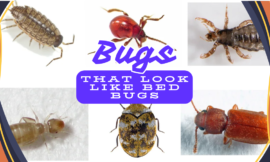Finding tiny red bugs crawling around your home or garden can be concerning, especially when you can’t identify them. Most people immediately think of clover mites, but not all tiny red bugs are clover mites. Various species of tiny red insects can invade homes, damage plants, or even cause skin irritation. It’s essential to identify the specific bug species you’re dealing with to apply the right treatment and prevent infestations.
In this blog post, we’ll discuss the common tiny red bugs that aren’t clover mites, how to differentiate them, and most importantly, how to get rid of them effectively. By understanding these pests, you can protect your home, garden, and family from any potential harm. Let’s explore the types of tiny red bugs you might encounter, the risks they pose, and the best ways to eliminate them.
1. Tiny Red Bugs Not Clover Mites: A Comprehensive Guide
While clover mites are among the most common tiny red bugs people encounter, there are several other species that can invade your home and garden. These bugs vary in behavior, habitat, and the type of damage they cause, making it crucial to differentiate them from clover mites for effective pest control. Let’s take a closer look at the most common types of tiny red bugs that aren’t clover mites:
- Chiggers: Also known as red harvest mites, chiggers are larvae of a type of mite and are notorious for causing itchy bites. Chiggers are typically found in outdoor areas like forests, grasslands, and gardens. Unlike clover mites, which don’t bite humans, chiggers latch onto the skin and feed, causing red, itchy bumps.
- Red Spider Mites: These tiny red arachnids are often found in gardens and greenhouses, where they feed on plant sap. Spider mites are plant pests that can severely damage your crops or indoor plants by leaving yellow or brown spots on leaves. Spider mites can spin fine webs on plants, making them easier to identify.
- Red Flour Beetles: These bugs are not mites at all, but rather beetles that infest stored food products like flour, cereal, and grains. Red flour beetles are small, reddish-brown insects that can contaminate food supplies, making them a nuisance in kitchens and food storage areas.
By understanding the different types of tiny red bugs, you can properly identify the pest causing the problem and choose the right method to eliminate them.
2. Types of Tiny Red Bugs: Not Just Clover Mites
When identifying tiny red bugs, it’s important to note that clover mites are just one of many species you may encounter. Here are a few common types of tiny red bugs that are often confused with clover mites:
1. Chiggers (Red Harvest Mites)
Chiggers are a type of mite, but they behave very differently from clover mites. Unlike clover mites, which don’t bite, chiggers are parasitic and can latch onto human skin, causing severe itching and irritation. Chigger bites typically result in clusters of small red bumps, particularly around areas where clothing fits tightly against the skin.
2. Red Spider Mites
Red spider mites are commonly found on plants, both indoors and outdoors. They are extremely small, often less than 1 mm in size, and they tend to infest leaves and stems, causing plant discoloration. If left untreated, red spider mites can weaken or even kill plants.
3. Red Flour Beetles
Unlike mites, red flour beetles are actual beetles that infest stored food products, such as grains, flour, and rice. These beetles don’t bite or cause skin irritation, but they can contaminate your food, making it inedible. These beetles are commonly found in kitchens, pantries, and food storage containers.
Knowing the different types of tiny red bugs helps homeowners target the infestation more precisely and prevents confusion between harmless bugs and those that pose health risks. Next, let’s look at how to identify tiny red bugs to confirm which species is in your home.
3. How to Identify Tiny Red Bugs in Your Home and Garden (300 words)
Accurately identifying tiny red bugs is the first step toward effective pest control. Here’s how to identify them based on key characteristics:
1. Clover Mites:
- Size: Extremely small, about the size of a pinhead (less than 1 mm).
- Color: Bright red.
- Behavior: Clover mites do not bite, and they are harmless to humans and pets. They are often seen in large numbers around windows, walls, and plant beds.
2. Chiggers:
- Size: About 0.3 mm in size.
- Color: Bright red to orange.
- Behavior: Chiggers latch onto the skin of humans and animals, causing itching and irritation. They are typically found in grassy, wooded areas and are active during the warmer months.
3. Red Spider Mites:
- Size: Less than 1 mm.
- Color: Red or reddish-brown.
- Behavior: Spider mites feed on plant sap, leaving discolored or speckled patches on leaves. They can also spin thin webs on plants.
4. Red Flour Beetles:
- Size: About 3-4 mm long.
- Color: Reddish-brown.
- Behavior: These beetles infest stored foods like flour, cereals, and grains, contaminating them and rendering them unsafe to eat.
By understanding these identifying characteristics, you can pinpoint the exact type of tiny red bug you’re dealing with and take the appropriate steps to eliminate them from your home or garden.
4. Why You Shouldn’t Ignore Tiny Red Bugs: Are They Dangerous?
While some tiny red bugs, like clover mites, are harmless to humans, other species can pose health risks or cause significant damage to your home and plants. Here are a few reasons why you shouldn’t ignore certain types of tiny red bugs:
1. Chiggers: Skin Irritation and Bites
Chiggers are among the most irritating tiny red bugs, as they feed on human skin cells. When a chigger bites, it injects digestive enzymes into the skin, causing intense itching and red welts. Chigger bites are often mistaken for mosquito bites, but they tend to itch more persistently. Scratching the bites can lead to infections.
2. Red Spider Mites: Plant Damage
Although spider mites don’t bite humans, they are notorious for damaging plants. They feed on plant sap, weakening the plant and causing the leaves to develop yellow or brown spots. If not treated promptly, red spider mites can cause the plant to wilt and die, particularly in greenhouses or indoor environments where the infestation can quickly spread.
3. Red Flour Beetles: Food Contamination
Red flour beetles are not harmful to humans, but they can contaminate food supplies. These beetles infest pantry items like flour, cereal, and rice, rendering the food inedible. They can quickly spread throughout your kitchen if left untreated, leading to costly food loss.
4. Why You Shouldn’t Ignore Tiny Red Bugs: Are They Dangerous?
Ignoring these tiny red bugs could result in damage to your home, plants, or personal health. It’s important to address infestations promptly to avoid long-term issues.
5. How to Get Rid of Tiny Red Bugs in Your House
Now that you’ve identified the type of tiny red bug you’re dealing with, it’s time to take action. Here are effective ways to get rid of tiny red bugs, whether they are in your home, garden, or pantry:
1. Vacuuming and Cleaning
For carpet beetles and clover mites, regular cleaning is crucial. Vacuum your carpets, curtains, and furniture thoroughly to remove eggs, larvae, and adult bugs. Pay special attention to cracks and crevices where they may hide. Discard vacuum bags immediately to prevent the bugs from re-infesting.
2. Insecticides and Sprays
Use insecticides labeled for specific bugs like chiggers, spider mites, and red flour beetles. Spraying along windowsills, baseboards, and other entry points can help keep bugs from entering your home. For plants affected by spider mites, look for miticides specifically designed to target them.
3. Diatomaceous Earth and Natural Remedies
For those seeking natural solutions, diatomaceous earth is an effective option. This non-toxic powder dehydrates and kills insects like spider mites and red flour beetles. Sprinkle it around affected areas, and leave it for a few days before vacuuming it up.
4. Seal Cracks and Gaps
Prevent future infestations by sealing cracks and gaps around windows, doors, and foundations. Many tiny red bugs, like clover mites and spider mites, enter homes through small openings. Caulking and weatherstripping can help keep them out.
5. Professional Pest Control
If the infestation is severe or persistent, it may be best to call a professional exterminator. They can assess the situation and apply more powerful treatments to eliminate the bugs and prevent future outbreaks.
6. Preventing Tiny Red Bug Infestations: Tips for Homeowners
Prevention is key to keeping tiny red bugs from invading your home. Here are some tips to prevent future infestations:
1. Maintain Cleanliness
Regularly vacuum and dust your home, especially in areas where bugs may gather, such as baseboards, windowsills, and corners. Carpet beetles and spider mites thrive in areas with dust and debris.
2. Inspect Plants
If you keep houseplants, inspect them regularly for signs of spider mites or other pests. Remove any damaged leaves and wash the plants with insecticidal soap to prevent infestations from spreading.
3. Proper Food Storage
To avoid attracting red flour beetles, store pantry items like flour, cereal, and grains in airtight containers. Regularly check your pantry for signs of infestation and throw away any contaminated food.
4. Seal Entry Points
As mentioned earlier, sealing cracks, gaps, and crevices around windows and doors will prevent bugs like clover mites and other tiny red insects from entering your home.
5. Monitor Outdoor Areas
Keep an eye on outdoor areas, such as gardens and patios, where chiggers or spider mites may be present. Consider using yard treatments to eliminate chiggers from grassy areas, especially during warm months when they are most active.
By following these preventive measures, you can significantly reduce the chances of a tiny red bug infestation in your home or garden.
For more exciting blogs, visit our homepage Magzineco.
FAQs About Tiny Red Bugs Not Clover Mites
- What are the tiny red bugs I’m seeing that aren’t clover mites?
Other than clover mites, you might be seeing chiggers, red spider mites, or red flour beetles. - Do tiny red bugs bite?
Some, like chiggers, bite and can cause itchy welts, while others, like spider mites, damage plants but don’t bite humans. - Are tiny red bugs dangerous?
Certain types, like chiggers, can cause skin irritation, while others like red flour beetles can contaminate food. - Can I use natural remedies to get rid of tiny red bugs?
Yes, diatomaceous earth and insecticidal soaps can be effective natural remedies to eliminate tiny red bugs. - How can I prevent tiny red bugs from infesting my home?
Regular cleaning, sealing entry points, and proper food storage can help prevent tiny red bug infestations. - Do tiny red bugs damage plants?
Red spider mites are particularly harmful to plants as they feed on the sap, causing leaves to yellow and weaken. - Where do chiggers come from?
Chiggers are commonly found in grassy or wooded areas, and they attach to human skin when you walk through their habitat. - How can I tell if my pantry has red flour beetles?
If you find small reddish-brown beetles in your flour, cereal, or other stored food, it’s likely that your pantry is infested with red flour beetles. - How can I get rid of chigger bites?
Anti-itch creams and cold compresses can help relieve the itching caused by chigger bites. - When should I call a professional exterminator?
If the infestation is widespread or if DIY methods aren’t working, it’s a good idea to call a pest control professional.
Conclusion
Tiny red bugs, whether they’re chiggers, red spider mites, or red flour beetles, can cause a range of issues in your home or garden. From skin irritation to plant damage and contaminated food, identifying and eliminating these pests quickly is essential for maintaining a clean and healthy living environment. While not all tiny red bugs are dangerous, some pose significant risks to your property and health, which is why early detection and treatment are crucial.
By following the tips outlined in this guide, you can effectively identify the tiny red bugs infesting your home, take steps to eliminate them, and implement preventive measures to keep them from coming back. Whether you’re dealing with chiggers in your yard or red flour beetles in your pantry, there are solutions to help you regain control of your home and protect your family.




